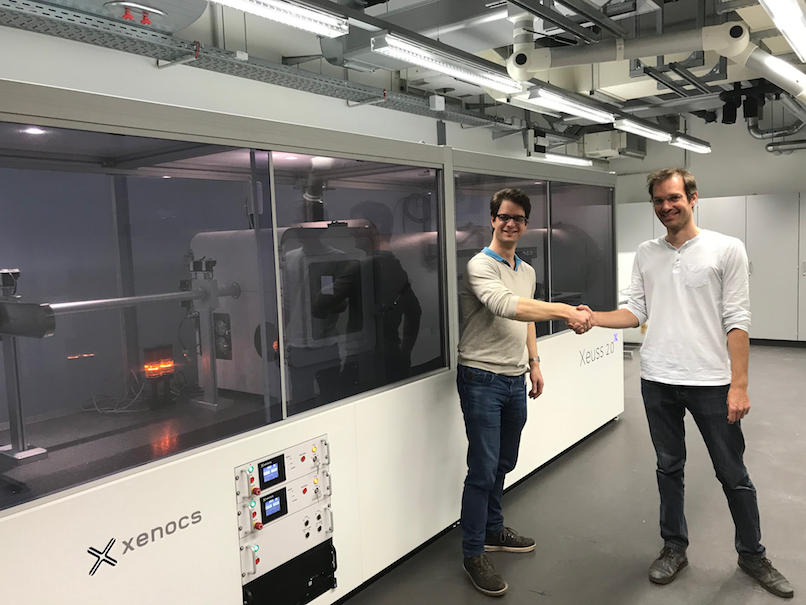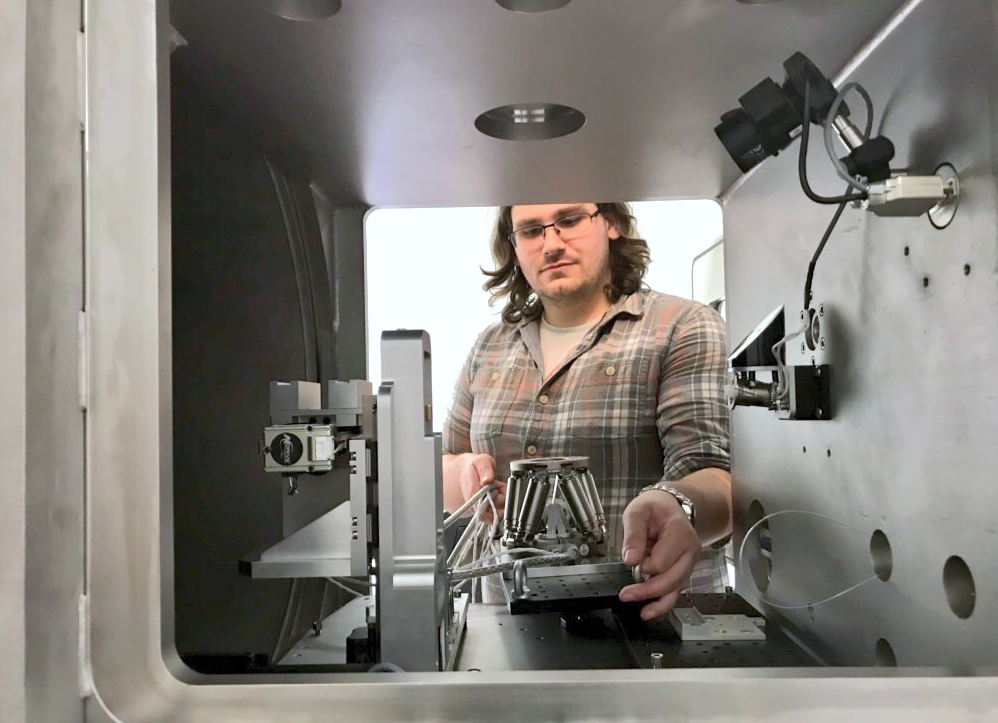
If you are interested in adding X-ray scattering to your project, but you:
- have no idea how, or
- need a really good instrument, or
- have a complex system that needs expert processing and analysis,
you can collaborate with us to give your project that scattering viewpoint. We can offer a guided experience where we will assist in the planning, measurement, correction, analysis and interpretation of all your scattering-related questions, suitable for experts and beginners alike.
Why not just go to a synchrotron?
The big benefit of our instrument compared to synchrotrons is time: we have longer time-slots available on very short notice. This allows you to do rapid proof-of-principle measurements, long-duration in-situ experiments (up to several weeks), and lets you to return regularly with optimized and fine-tuned experiments and samples. We also have more time available ourselves for in-depth collaboration on the various research topics.
Essentially, if you don’t need very fast measurements: you can do your experiments with us, and we’ll get you good quality data. If it is flux you need, for example for fast in-situ monitoring or for very large amounts of samples, we can recommend some excellent synchrotron beamlines to you.
Why do you do this?
BAM, is a government-funded institute, whose primary goal is to help industry and academia answer their materials-related questions. To achieve this, BAM invests (amongst others) in instruments, and – more importantly – people with years of associated expertise. We spend part of our time improving our knowledge by doing our own research, but we are also available for collaborations within, and on the boundaries of our expertise.
That means that you do not need to buy expensive equipment to do your occasional specialized experiment, and that you do not need to spend years developing the knowledge necessary to make correct educated guesses on what your techniques are really telling you. Instead, you can bring your questions to us. As mentioned in another post, such collaborations really benefit both you and us equally: you get help with the application of an interesting, yet challenging technique, and we get better insights on how to answer a very wide range of questions (as well as the occasional co-authorship, see below).
Types of collaborations
So, to put it more concretely, if you are doing materials science, and you want to add a SAXS or WAXS investigation to your analyses, you can contact us. Or, if you are in, or near Berlin, drop by for a chat! We will quickly find out if your experiment is feasible on our top-of-the-line lab instrument, or if you really need the special powers that a synchrotron has to offer. If our labs will do, we can collaborate in one of three ways:
- Industrial collaborations: If you need the investigation for an internal research project, and the investigations are not intended for public release, industrial collaborations are the choice for you. In this case, we will happily help you out for a standardized fee.
- Research collaborations: As a government institute, BAM is eligible to apply for special sources of funding, such as DfG or special EU funds. We are always happy to join such (and other) funding applications as a partner. This is particularly useful for larger research projects.
- Basic research: This is the option we have been exploring in the past few months, and has now become available. If you have a research project and you need us, we may help you with all SAXS/WAXS aspects of your research, including some interpretation. Co-authorships on the papers where we have provided an intellectual contribution are expected, and indeed very helpful, as they allow us to justify this way of working.
- Bonus option: If you are a student, you can also do a Bachelor, Master, Ph.D. or Post-doc project in our labs. You do need a university supervisor, but we do host a legion of excellent students and post-docs throughout BAM. We particularly appreciate it if you come with your own project plans. More info here.
So do you accept everything?

Unfortunately not. We are limited in measurement time and our staff time, so we can only accept some projects, and we will ramp up slowly over the next few months. Until we are oversubscribed, we will only check project and collaboration proposals for technical feasibility, as well as our group emphases (protein scattering, for example, is at the moment not one of our core expertise). We also make a prioritization of measurements, but we typically manage to return most samples within two weeks.
Once we start getting oversubscribed, we will start with frequent calls for proposals with regular deadlines. Proposals in this case are very brief excel sheets where a little basic information can be provided. Examples will follow shortly.
For researchers abroad, there is also the option mailing in the samples, saving a ton of CO2 and money.
What samples can you measure?
There will be a more extensive gallery later, but here’s a brief cross-section on what we can measure:
- Nanoparticles in solid- or liquid dispersion
- Porous materials, including: SBA, MOFs, membranes, fibres
- Polymer materials, both amorphous and (semi-)crystalline
- Precipitates in alloys (aluminium-, magnesium-based alloys or steels in particular)
- Composite materials
- Glassy materials
- milk, ink, water, etc.
- Some deposited surfaces as well, although we do not have much experience yet with grazing incidence.
- A variety of other powders, sheets, films, liquids, gels,
We haven’t got many in-situ set-ups yet, but we are expanding based on need. We expect soon to be able to do:
- in-situ heating to moderate temperatures (< 500 ˚C), also with fast ramp rates
- in-situ tensile testing
- flow-through sampling of reactions
- measurements under moderate, static magnetic fields (< 0.5 T)
We specialize in:
- Wide-range measurements of static samples, from 0.02 < q(1/nm) < 90. Soon to be extended with USAXS, adding the range of 0.002 < q(1/nm) < 0.02.
- calibrated measurements, absolute units and uncertainties on the intensity, traceable Q-vector calibration
- full data correction method developments
- advanced analysis method developments
- complex samples
- aligned, anisotropic structures
- medium- to slow dynamics studies (to study processes lasting up to several weeks, with time steps of several minutes), such as room-temperature ageing studies or slow synthesis reactions.
We cannot do:
- Weakly scattering samples
- Anomalous scattering investigations
- fast dynamics investigations
- highly absorbing or thick samples
- high-resolution diffraction
- samples under atmosphere
Is it just the MAUS you’re sharing?
For the Basic Research-type of sharing, yes, until we demonstrate that this way of working makes sense. For the Industrial Collaborations and Research Collaborations, we have more equipment available, including another flow-through SAXS machine and an advanced multi-angle static- and dynamic light scattering machine.
About the MAUS

I’ve been planning to build the MAUS ever since I started in Japan. Over the years, the ideas and knowledge gained from looking at other instruments were combined, and put in various instrument building proposals. After starting at BAM, this proposal was accepted. However, given the strings attached, and following the recommendations from the readers of this blog, it was decided not to build this myself, but to let the instrument be built. All the ideas were put in a highly detailed request for quotations, and the proposal received from the French manufacturer Xenocs was chosen, allowing them to build our custom-designed instrument.
The instrument is now constructed, and we have finished commissioning most of the components in 2018. We always continue modifying and adding to the instrument and the methods to keep the instrument and periphery on the cutting edge, however.
The instrument itself is quite unique, combining several nice features. It has both copper and molybdenum microfocus X-ray sources with parallelization optics, mounted on a motorized stage for automatic source switching. The sources emit 8 and 17 keV photons to accommodate a wide range of samples. The collimation section has three sets of scatterless slits, leading to a nice clean beam. The instrument is equipped with an enormous sample chamber, offering a luxurious internal space of 500x500x600 mm, an on-axis alignment microscope, and various sample stages including a miniature hexapod for grazing incidence work. The detector is an in-vacuum Eiger 1M on a three-axis stage. This lets us move it to any desired position with respect to the beam and sample, with sample-to-detector distances of mere centimetres to 2.5m. Our Q-range spans nearly four decades from , allowing us to seamlessly analyse structural dimensions ranging from 0.6 Ångström to 300 nm.
The enormous vacuum tube and sample chamber does require a while to pump down, it takes about six minutes to reach 1 mbar of pressure. Venting it takes about 1.5 minutes. Rather than doing many quick sample changes, it is rather recommended to load up large plates of samples at a time.
The data we get out of it is stored in the NeXus format, and processed using the DAWN data analysis package using our standard-setting processing pipelines.
Will there be paperwork?
Only the bare minimum, as a little bit of paperwork cannot be avoided. Mostly, we need you to fill in some paperwork to correctly register and handle your project, samples and measurements.
So is this all you do now?
No, we mainly do research for ourselves and our group, and we assist other BAM researchers with their projects too. Besides these, however, there is still plenty of capacity on the machine available, and we can usually spend a moment or two providing a judgmental look on the resulting data. We think we can do some pretty amazing measurements, so now we’re cross-checking this assumption with the rest of the world.
Let’s find out how good we really are!
P.S. is any of this legally binding?
No. This is a personal weblog. What I write here is only what I understand, and I only speak for myself (even when I use the royal “we”). I cannot guarantee that it is a correct interpretation, and so some details might not be correct. I do try to be correct, though!
